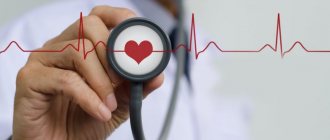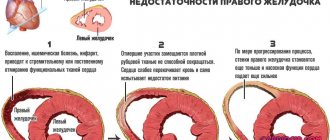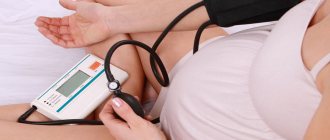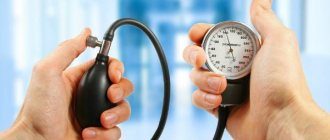Children, like adults, may experience fatigue and dizziness. Such complaints should not always be perceived as whims. In some cases, low blood pressure, or hypotension, is determined, which sometimes indicates the development of complex and life-threatening conditions for the child.
Hypotension is the clinical definition of low blood pressure. This condition disrupts homeostasis in the body, depriving the brain, heart and other vital organs of oxygen and nutrients.
Blood pressure, like pulse, respiratory rate and body temperature, is one of the main biological indicators, so it is extremely important to monitor its value in a timely manner.
Hypotension can be detected in various childhood diseases. In some cases it has extremely important diagnostic value, in others it has no particular value. Blood pressure in children is most often determined by a tonometer, which can be placed on the finger of very young children and automatically display the measurement result in a minute or two.
Video: HYPOTENSION, low blood pressure: causes, symptoms, how to treat.
Causes
In infants, muscle hypotonia can occur for a number of reasons.
All possible options are divided into two large groups: Congenital include those that arose during pregnancy:
- genetic (in which case hypotension is usually a manifestation of more serious disorders);
- caused by developmental defects.
Acquired ones occur during childbirth or after birth:
- neurological (for cerebral palsy, difficult childbirth, obstetric errors, etc.);
- post-infectious (muscle hypotonia in children under one year of age can develop after a complex illness (meningitis, botulism, etc.));
- toxic (due to poisoning);
- metabolic disorders (with physiological jaundice, rickets, hypothyroidism, hypervitaminosis, etc.);
- autoimmune (complications after vaccines, etc.);
- as a manifestation of genetic abnormalities, etc.
Prevention
The disease can only be prevented if you follow the recommendations of a specialist. To do this, the child needs:
- Eat healthy foods;
- Monitor sleep and rest patterns;
- Avoid stress and nervous tension;
- Exercise;
- Take vitamin complexes.
Preventive measures help not only to avoid the onset of the disease, but also to speed up the recovery process for existing pathology. If a child has hypotension, the prognosis depends entirely on how seriously the parents take treatment. If you take all the necessary measures in time, the risk of complications is reduced to zero.
Related Articles
Invasive blood pressure measurement
How to determine blood pressure by pulse
Nocturnal hypertension
Can hypertensive patients fly on an airplane?
Is it possible to exercise if you have hypertension?
Different pressure on the hands - what does this mean?
Types of muscle hypotonia in a child
There are several types of this syndrome based on different characteristics.
Depending on the scope of hypotension, there are:
- asymmetrical (on one side of the body);
- symmetrical (on both sides).
By the number of affected organs:
- local (violations of only one part of the body);
- diffuse muscle hypotonia in children (from two or more areas of the body).
Diffuse hypotension syndrome can vary from mild weakness to complete inability to move.
In the most difficult condition, the child cannot even swallow food, chew, or suck; he often experiences dislocations. However, even with mild severity, muscle hypotonia in children after one year significantly affects the baby’s posture and motor functions. Over time, he will begin to lag behind in physical development, and will also begin to speak late.
Preventive actions
To prevent the development of hypotension in a newborn, a pregnant woman will need to stop drinking alcoholic beverages and smoking. In addition, it is important to monitor your health and contact a medical facility if any disease develops. If we talk about older children, then a properly selected diet will help reduce the likelihood of a persistent decrease in blood pressure. You should remove sweets, salty foods, fatty and fried foods from your diet. The menu focuses on protein foods. Such products include legumes, eggs, lean fish and meat. In addition, an important preventive measure is an active lifestyle, gentle sports and regular walks in the fresh air.
Diagnostics
Muscle hypotonia is detected in a newborn immediately after birth or in the first months of life.
A healthy child has increased muscle tone, so his arms and legs are bent, and he resists during examination, etc. if the child is sick, his body will be relaxed, his head will be thrown back. His limbs will feel very soft to the touch and his girth will be smaller in diameter. For diagnosis, tests are carried out:
- traction (the baby is pulled by the arms into a sitting position);
- determination of passive tone (range and strength of movements);
- determination of active tone;
- hanging horizontally;
- measuring muscle mass.
Treatment
Treatment is carried out using comprehensive measures aimed at stimulating damaged muscles and increasing their tone.
It includes:
- massages (at home and with the help of professionals);
- physical therapy;
- physiotherapeutic procedures (electrical stimulation);
- development of fine motor skills;
- proper nutrition (with enough microelements);
- taking medications (tonic, antiviral, for the treatment of myasthenia gravis, etc.);
- control of correct gait, posture, use of a corset.
Exercise therapy for muscle hypotension includes a number of special exercises that are selected by the doctor individually for each child.
The main thing is that parents do not give up and diligently help the baby develop correctly. This syndrome can be eliminated, and the child can grow up normal with timely and proper treatment.
How to treat?
The method of treating hypotension is also selected individually based on the patient’s age, as well as the presence of concomitant diseases. Drug treatment is prescribed only if symptoms of hypotension appear regularly and correction of the baby’s lifestyle has not brought the expected results.
The following groups of drugs are used in therapy:
- central nervous system stimulants;
- tranquilizers;
- antidepressants;
- nootropic drugs;
- anticholinergic drugs;
- diuretics.
The principle of use and duration of medication is determined by the doctor.
It is strictly forbidden to stop the course of therapy on your own.
Physiotherapy is indicated in combination with traditional treatment for hypotensive patients. A very good effect, especially in the treatment of newborns, comes from massage of the collar area, calf muscles, hands and electrophoresis. Contrast and circular showers and underwater massage showers have a great effect on the well-being of teenagers. Doctors can also recommend mineral baths, psychotherapy, and spa treatment.
Causes of muscle hypotonia in children
Impaired muscle tone may indicate a malfunction in the central nervous system, be a genetic defect, or appear as a result of an injury. But the reliable reasons for the development of pathology are still unknown.
As a symptom, muscle hypotonia can be observed in a variety of diseases:
- Down syndrome is a genetic pathology in which an abnormality of the 21st pair of chromosomes is observed.
- Myasthenia gravis is a neuromuscular disorder characterized by rapid muscle fatigue.
- Prader-Willi syndrome is a congenital pathology in which several genes are missing in one of the chromosomes; characteristic symptoms of the disease are increased appetite, leading over time to obesity, short stature, mental retardation and decreased function of the gonads.
- Severe reactive jaundice is a disorder caused by a conflict between the Rh factors of the mother and child.
- Botulism is an infectious disease in which microorganisms secrete a toxin that paralyzes muscle fibers.
- Achondroplasia is a hereditary disease in which the growth of cartilage tissue and bones slows down, and as a result, the development of dwarfism
- Cerebellar ataxia is a movement disorder resulting from damage to the structure of the cerebellum.
- Marfan syndrome is a hereditary pathology that develops due to gene mutation; classic symptoms are long limbs, fingers, lack of subcutaneous fat, damage to the visual organs and the cardiovascular system.
- Sepsis is a severe infectious pathology that occurs when microorganisms or their toxins enter the blood, resulting in the development of inflammatory processes throughout the body.
- Congenital hypothyroidism is a disease characterized by decreased function of the thyroid gland.
- Rickets is a lack of vitamin D in the body, which leads not only to muscle hypotension, but also to disorders in bone tissue.
- Hypervitaminosis D is a condition that develops due to taking large doses of the vitamin.
- Spinal muscular atrophy of the first type is a large group of hereditary diseases in which the common symptom is disturbances of voluntary movements - swallowing, walking, etc.
- Adverse reactions after vaccinations.
Physiotherapy methods
The main objectives of physiotherapeutic measures are to increase the tone of the body, normalize blood pressure, improve blood circulation and strengthen the heart, vascular and nervous systems. The best ones for this are:
- Therapeutic physical culture;
- Massage sessions;
- Electrophoresis with magnesium sulfate;
- Acupuncture;
- Mineral baths.
At home, you can take a contrast shower, as it has a good effect on the child’s body and helps stimulate the functioning of the cardiovascular system. Doctors often recommend baths with sea salt, essential oils and valerian.
Contrast shower improves blood circulation and strengthens the immune system
Manifestations
Muscle hypotonicity can be diagnosed both at birth and a little later, at an appointment with a neurologist. Usually problems with muscle tone are suspected if the following manifestations are present:
- incorrect step reflex and reaction to the support of the legs - it is normal when the child is placed with his legs on the surface, he tries to make several movements, as if trying to walk. Supporting the legs with the full foot creates a reflexive response, and the baby actively moves the feet. If a child has hypotension, then such actions cannot be expected from him - babies do not try to stomp, but passively press their legs together, as if they are trying to sit on their butts. The reflex lasts for about two months, after which it fades, so you can check hypotonicity in this way during this period;
- sitting down reflex - if the baby is placed on a hard surface and held in the wrists, the child will try to pull himself up with his arms and try to sit up. While holding your baby, you can feel tension in his arms and shoulder muscles, which indicates normal muscle tone. Children with hypotonia cannot make such movements - their arms hang when supported, their necks cannot be supported when they try to stand up, and their back remains rounded.
In addition to reflex signs, parents can also notice muscle hypotonia based on the baby’s behavior. The child is usually quiet and calm, it is not easy to play with him or attract persistent attention to something. Most of the time, such babies sleep, and periods of activity are short in time.
Sleep position also signals decreased tone in babies. Babies do not sleep in the fetal position; their positions are usually relaxed, with their palms unclenched. Even widely spread legs do not cause discomfort to such children, so sleeping babies with hypotension can be recognized by their bizarre poses.
If the tone is reduced, children have a harder time straining their necks and hold their heads up later than their peers. It is much more difficult for them to roll over on their side, crawl and grab some objects. Maintaining the body in a sitting position is almost impossible - even with a forced sitting at 8 months, children, like nesting dolls, strive to lie down.
If such symptoms occur, parents should not draw premature conclusions - such signs of hypotonicity may be erroneous and indicate other neurological disorders. To make a diagnosis, you need to go to the clinic and undergo an examination by a doctor, finding out the reasons for this behavior of the baby.
Symptoms
The disease is rarely asymptomatic and, as a rule, the little patient’s health deteriorates significantly.
If a child is constantly weak and does not enjoy playing, this is a reason to consult a doctor.
Hypotension can be recognized by characteristic signs:
- Persistent low blood pressure;
- Nausea and dizziness;
- General weakness and constant fatigue;
- Frequent headaches;
- Presyncope;
- Excessive irritability;
- Pain in the heart area;
- Feeling of chest tightness;
- Drowsiness, sometimes apathy.
If hypotension occurs in a baby under one year old, you need to carefully monitor his condition and behavior. With this pathology, infants often have problems with urination and fecal discharge. The skin becomes paler, the baby often burps and the pulse often drops. In addition, symptoms tend to intensify with sudden changes in weather conditions.
Causes
Decreased tone is directly related to the functioning of the central nervous system and the activity of the blood supply. The appearance of hypotension occurs under the influence of the following factors:
- hypoxia or asphyxia during childbirth;
- rapid labor;
- severe pregnancy with intoxication or gestosis;
- the presence of bad habits in the mother;
- exhaustion of the baby after an infection;
- genetic disorders;
- developmental defects;
- light weight;
- excess cholecalciferol.
Consequences
Hypotonia has serious consequences for the baby, so doctors insist on early diagnosis and elimination of signs of the disorder as early as possible. Usually, with treatment, it is possible to eliminate the manifestations of hypotension within up to a year. Otherwise, serious disorders may develop - curvature of the spinal column, incorrect posture.
Note that with hypotension in newborns, the pressure on the internal organs increases, since the child does not hold himself in an upright position. In the future, bone growth in such babies slows down, since there is no necessary muscle tone for growth. Children with hypotonia lag behind their peers in development and speak poorly.
Children who previously suffered from hypotension are usually characterized by excessive flexibility and plasticity in childhood, but later, when active skeletal growth begins, a decrease in tone provokes the progression of various pathologies of the musculoskeletal system. The most dangerous condition is complete muscular dystrophy.
Description
Hypotension is most often a symptom of another, underlying disease, and due to its mechanism of development, duration and characteristics of the clinic, it can be quite heterogeneous. The mechanisms of development of hypotension can be different:
- The minute and stroke output of the heart decreases.
- Peripheral vascular resistance decreases.
- The volume of circulating blood decreases.
- Insufficient venous return of blood to the heart.
These hemodynamic changes can be combined or occur in isolated form. To more accurately determine the main characteristics of hypotension, there is its classification.
- Acute hypotension - occurs due to a sharp decrease in blood pressure.
- Chronic, which can be: Primary - is a separate disease, also defined as essential or idiopathic hypotension.
- Secondary - occurs against the background of other diseases, therefore it is considered their symptomatic manifestation.
a physiological decrease in blood pressure is separately distinguished , which most often does not go beyond the lower limits of normal and the child feels well. In such cases, doctors talk about the body's innate predisposition to reactions associated with low blood pressure.
Orthostatic hypotension is another form of low blood pressure, which is characterized by the appearance of signs of impairment when moving from a horizontal to a vertical position. In children, such a disorder is often associated with changes in neurological reactions. When they are disturbed, vascular tone does not respond so quickly to changes in body position, resulting in symptoms characteristic of hypotension.
Indicators of normal blood pressure in children depending on age, presented by PALS Guidelines, 2015, are provided.
| Age | Systolic pressure | Diastolic pressure | Systolic hypotension |
| Newborns (12 hours, <1000 g) | 39-59 | 16-36 | <40-50 |
| Newborns (12 h, 3 kg) | 60-76 | 31-45 | <50 |
| Newborns (96 hours) | 67-84 | 35-53 | <60 |
| Infants (1-12 months) | 72-104 | 37-56 | <70 |
| Toddlers (1-2 years old) | 86-106 | 42-63 | <70 + (age in years x 2) |
| Preschoolers (3-5 years old) | 89-112 | 46-72 | <70 + (age in years x 2) |
| Schoolchildren (6-9 years old) | 97-115 | 57-76 | <70 + (age in years x 2) |
| Pre-teenage (10-11 years) | 102-120 | 61-80 | <90 |
| Teenagers (12-15 years old) | 110-131 | 64-83 | <90 |
Treatment
If a baby is diagnosed with weak muscle tone, then at the initial stage the doctor will recommend the most effective conservative treatment - gymnastics and massage. Therapeutic exercise is carried out both in the air and in the water.
Water treatments
Breast swimming is a great way to work all muscle groups. Swimming is recommended both for increased tone and for hypotonicity, but when relaxing muscles, swimming has its own characteristics. The most important thing is the need to swim without a circle around your neck. For children with normal tone or hypertonicity, this will not be a problem, but for children with weak neck muscles, the circle can only cause harm and cause injury.
Swimming harmoniously develops and strengthens all muscle groups
The child must be supported by hands and perform all actions exclusively with support. For convenience, you can lay a mat in the water and pour only a little water, not completely covering the baby’s body. You can also install a special fabric sunbed for bathing so that mom’s hands are free.
Gymnastics in water can be started after the umbilical wound has healed. For up to two months, the exercises are performed in the pool, and later you can try exercising in the infant pool with an instructor. Treatment of hypotension with water gymnastics is carried out when the child is in a good mood, when he is full, but not earlier than thirty minutes after feeding.
Exercises for a baby with hypotension are as follows:
- vertical immersion (if necessary, the head must be secured by the second parent);
- horizontal immersion;
- rocking on the water;
- “swimming” on the stomach with the support of the chin (excellently strengthens the neck muscles);
- pushing the legs away from the side;
- “jumping” at the bottom of the bath;
- moving along the bottom of the bath to a bright object (ball, toy);
- clapping your palms on the surface of the water;
- “bicycle” lying on a sunbed.
The time for performing gymnastics in water is no more than fifteen minutes. In the future, the child will get tired, show dissatisfaction, and subsequent water procedures will turn not into productive exercises for hypertonicity, but into hysterics.
What is muscle hypotonia in adults and children
Muscular hypotonia is a pathological condition characterized by a decrease in the tone of muscle fibers. The disease occurs not only in adults, but also in children, even newborn babies. Muscle hypotension accompanies many serious pathologies, which cannot but be alarming. A doctor, relative, or the sick person himself, who notices weakness of muscle tissue, must immediately take all measures to eliminate the unpleasant syndrome. So how does pathology manifest itself and how to treat this unpleasant syndrome? Let's figure it out.
Definition and classification
Muscle fibers, which are often collected in bundles, provide one of the most basic human functions - the ability to move. Muscles hold the body in an upright position, provide movement of the limbs, participate in the act of breathing, etc. Tone determines the tension of muscle tissue or the ability to resist movement.
The syndrome is classified into diffuse and local forms of hypotension. In the local form, a specific group of muscle fibers suffers. Diffuse muscle hypotonia is characterized by the involvement of all muscles of the body. Children with this form of the disease lie in a prone frog position. It is diffuse muscular hypotension that is more difficult to correct and treat. This worsens the patient's prognosis.
Symptoms and complications
Depending on the cause of occurrence, the age of the patient and the severity of the pathologies, the clinical picture differs markedly. When examining newborns, without confirmation from a neurologist, such a diagnosis cannot be made, and in some cases, pathological changes appear much later.
Signs of muscle hypotension in children:
- When examined, the newborn reacts poorly to muscle irritation; reflexes do not work or are very weak.
- The child cannot hold his head, does not roll over from his back to his stomach, and cannot hold a toy in his hands.
- When lifting a child in your arms in a vertical position, the arms involuntarily rise up, and the baby may slip out of your hands.
- The sleeping position also “gives away” the disease: the child is fully straightened, the arms lie along the body, and are not bent at the elbows. When raised, the head tilts back, the limbs hang down.
- General delay in physical development; the child begins to hold his head up, sit, crawl, and perform other actions later than others.
Diffuse muscle hypotonia in children can be manifested by problems with respiratory function, absent or decreased reflexes, decreased activity and poor appetite due to difficulty sucking movements. Over time, such pathologies progress significantly, leading to retardation in mental and physical development, partial or complete muscle atrophy, curvature of the limbs and paralysis.
Pathologies of various types can progress for a long time without external manifestations. There are cases when a genetic deviation actively manifested itself only in adulthood, or during the period of hormonal changes in the body. The symptoms of hypotension are not so pronounced and for diagnosis it will be necessary to undergo a full examination of the body, including laboratory tests. In most cases, the diagnosis is made purely by chance, when visiting for another ailment.
Complaints from adult patients:
- Periodic or constant weakness throughout the body, regardless of working conditions.
- Frequent headaches that do not go away after taking painkillers.
- Pain in the chest, slight tachycardia.
- Pathological sleep disorders, manifested not only by insomnia, but also by increased sleepiness.
- Increased sweating without external causes or changes in temperature environment.
- Behavioral changes: increased tearfulness or irritability, frequent periods of depression.
- Numbness of the limbs at an advanced stage of the disease.
Ignoring such alarming symptoms can lead to serious complications, including disability. Most often, we are accustomed to attribute such manifestations to tiring work, nervous stress and the inability to properly rest. At the same time, a timely examination will help determine the true cause of such ailments, as well as take the right measures.
Causes
Muscle weakness can accompany dozens of diseases of neuromuscular origin. A hereditary factor is often traced. Then the signs of the disease appear from early childhood, or even infancy. A sign of muscle pathology is observed when the functioning of a peripheral motor neuron, certain areas of the spinal cord, or reticular formations of the brain stem are disrupted.
Almost all pathologies of the cerebellum, including tumors and acute ataxia, lead to disruption of the skeletal muscles. Symptoms in the syndrome of decreased tone accompany chorea, diachasis, etc., which worsens the course of the disease. Acquired causes of muscle hypotension include encephalitis, meningococcal infection, poliomyelitis, septic lesions, poisoning with vapors or mercury salts, myasthenia gravis, and excess vitamins (gapervitaminosis). A pathological syndrome can appear after suffering infectious, toxic, autoimmune, metabolic, or neurological illnesses.
Diagnostics
Due to the specific symptoms, diagnosing the disease is not difficult. The examination begins with a detailed collection of information about previous diseases, study of medical documentation, auscultation and percussion. All efforts are aimed at determining the root cause, for which they may additionally prescribe:
- laboratory diagnostics (general blood test, urine test, specific blood tests, etc.);
- MRI of various organs and systems;
- CT (computer diagnostics);
- genetic testing;
- electromyography;
- muscle tissue biopsy;
- cerebrospinal fluid examination;
- radiography.
Only by collecting all the research results can a final diagnosis be made and treatment prescribed. Typically, diagnosis takes some time, entails material costs, and tires the patient. But you cannot refuse medical recommendations, which is often done by careless parents who do not want to examine their child. This is a wrong, unacceptable tactic!
Hypotension in infants: symptoms
Dystonia in children is manifested by impaired muscle tone. This is a fairly common diagnosis. Dystonia can be associated with both hypertonicity and hypotension. Muscle hypotonia syndrome is often congenital. If its severity is weak or moderate, then the maternity hospital cannot always make a diagnosis. Attentive, caring parents are obliged to systematically monitor the condition of the muscle corset of their little child. This is how you can notice the symptoms of pathology at the earliest stages, which will allow you to both carry out effective treatment and avoid worsening the condition.
Hypotension in an adult
Symptoms of muscle hypotension in adults can be detected by chance: during a medical examination or during an examination for patient complaints. The symptomatic picture has varying degrees of severity and may appear much later than the underlying disease. Symptoms to look out for include:
- weakness, weakness throughout the body. It is not associated with physical activity or other factors. Appears on its own, for no apparent reason;
- sudden intense headaches that are not amenable to drug therapy. Even after taking a strong painkiller, the condition remains virtually unchanged;
- wavy, periodic tachycardia;
- in the retrosternal region the appearance of pain of a pinching nature;
- sleep disturbance (insomnia, pathological drowsiness);
- “looseness” of the joints, when movements in them have a much greater amplitude than in a healthy person;
- numbness of the limb;
- frequent sweating.
Symptoms of muscle hypotension may not significantly worsen a person's overall health. This allows you to postpone a visit to the doctor and “attribute” everything to an accelerated pace of life, physical inactivity, and physical labor. This is wrong practice. Only timely diagnosis and proper treatment can improve a person’s condition. It is often possible to stop the regression of the disease towards its worsening.
Samples (tests) for accurate diagnosis
In addition to general studies, the doctor conducts a number of tests that can accurately verify the diagnosis. Most often, especially if hypotonia of the lower extremities is suspected, the Orshansky test is performed: the patient is placed on his back, with one hand the knee joint is pressed against the couch, and with the other they try to lift the heel upward.
If the muscles are weak, this can be easily done - the limb is hyperextended. A similar situation is observed with a decrease in muscle tone in the upper extremities. Then hyperextension of the forearm is diagnosed.
The following symptom is characteristic of childhood hypotension: when lifting a baby by the armpits, only the shoulder girdles are involved in the process, and the head “falls” between them. This test is called “flaccid shoulder girdle”. The following technique is very indicative: the patient is placed face down on a hard surface. They are asked to bend the limb at the knee joint. If the muscles do not work under enough load, the heel will effortlessly reach the gluteal region. Additionally you can do:
- Poemny test: try to reach the area of the trochanter of the femur with your heel. A healthy person with normal muscle tone cannot do this.
- Two Openheim tests: in the first position: sitting, the patient will be able to reach the big toe with the lower jaw, in the second - throw the lower limb behind the head.
Arterial hypotension in children and adolescents
In this regard, expanding knowledge of the main etiopathogenetic mechanisms, features of the clinical course and treatment of arterial hypotension in childhood and adolescence is of particular relevance. Arterial hypotension is a symptom that reflects a decrease in blood pressure in the arterial system. Among the many classifications of hypotonic conditions for practical activities, including in pediatrics, the classification of N.S. is used. Molchanov (1962), where two variants of hypotension are distinguished. 1. Physiological hypotension, in which there are no subjective complaints, no symptoms of vegetative dystonia. This includes: – hypotension as an individual variant of the norm; – hypotension due to increased training (in athletes); – adaptive compensatory hypotension of residents of high mountains. 2. Pathological hypotension (primary and secondary). Primary arterial hypotension develops against the background of autonomic dystonia (VD) syndrome, in which there is a manifestation of clinical symptoms characteristic of increased parasympathetic tone of the ANS. Primary hypotension may have an unstable reverse course or occur in the form of a pronounced persistent form (hypotonic disease). With hypotension, there is a persistent decrease in blood pressure, accompanied by dizziness, headaches and orthostatic dysregulation. In pediatric practice, this diagnosis is not made, because the decrease in blood pressure in children and adolescents is reversible and its normalization is possible with age. Secondary (symptomatic) arterial hypotension is a consequence of organic pathology of the cardiovascular system (carditis, cardiomyopathy, heart rhythm disturbances); nervous system (tumors, hydrocephalus, post-comatose states, etc.); endocrine diseases (hypothyroidism, hypofunction of the adrenal cortex, polyneuropathy in diabetes mellitus); hematological pathology (anemia of various origins); chronic intoxication, as well as the result of the use of inadequate doses of medications (antihypertensives, certain antiarrhythmics, antidepressants, antihistamines). Obviously, arterial hypotension, which is one of the manifestations of autonomic dysfunction, is more appropriate to classify as secondary. Currently, primary arterial hypotension is considered as a multifactorial pathological condition, in the development of which endogenous and exogenous factors take part, in most cases acting in a complex manner. The main factors predisposing to the formation of primary arterial hypotension in children and adolescents are shown in Figure 1. The mechanisms of the development of arterial hypotension are complex and remain poorly understood. It is now considered proven that with hypotension there is a violation of the mechanism of autoregulation of central hemodynamics, expressed in the development of a discrepancy between cardiac output and total peripheral vascular resistance (TPVR) due to a decrease in the latter. At the same time, during the course of hypotension, OPSS continues to steadily decrease (Fig. 2). Various biologically active compounds with antihypertensive properties (nitric oxide, prostaglandins, taurine, natriuretic peptides, serotonin, kinins, etc.) are essential. In children and adolescents, the most significant mechanism for reducing peripheral vascular resistance is the autonomic one [1–4]. It is known that one of the most important functions of the ANS is vasomotor regulation. In the absence of autonomic imbalance, the interaction of the sympathetic (ST) and parasympathetic (PST) divisions of the ANS determine the adequacy of the autonomic influence on various functional systems of the body, and primarily on the activity of the heart and vascular tone. During VD, the interaction between the two sections of the ANS is changed, and both unidirectional ST–PST activity (compensation phase) and multidirectionality and uncoordination of their activity (decompensation phase) are possible. In the clinic, the unidirectionality of ST–PST activity is characterized by very moderate vegetative manifestations, accompanied by lability of vascular tone. Multidirectional ST–PST activity is characterized by maximum severity and manifestation of clinical symptoms, including vascular and muscular dyskinesias [5]. From the above it follows that arterial hypotension is characterized by miscoordination of the activity of two parts of the ANS with a pronounced predominance of PST (Fig.? 3). This is confirmed by the results of VNS spectrography [5], as well as changes in the content of neurotransmitters in the bloodstream, expressed in an increase in the level of acetylcholine and a decrease in the concentration of catecholamines [2,3]. Low activity of the sympathetic-adrenal system reduces the tone of precapillaries-arterioles, which is one of the leading hemodynamic factors in lowering blood pressure. In children and adolescents who have suffered a traumatic brain injury, with residual perinatal changes in the central nervous system, chronic psycho-emotional stress, a disruption of the neurogenic pathway of blood pressure regulation is often observed, as a result of a loss of balance between the processes of excitation and inhibition with the predominance of the latter in the cortex, in the stem structures, in the central vegetative centers with the formation of one of the forms of neurosis. In this case, hemodynamic disorders develop, one of the manifestations of which is endothelial dysfunction with a decrease in peripheral vascular resistance [1]. The mechanism of development of arterial hypotension in the presence of neurogenic and autonomic dysregulation is shown in Figure 4. Thus, the development of arterial hypotension in children and adolescents should be considered as a violation of a number of physiological regulatory mechanisms responsible for stabilizing systemic blood pressure. Clinical manifestations of arterial hypotension The main symptom of arterial hypotension is a decrease in blood pressure. The symptoms of hypotension are diverse, labile, transient, often transient in nature and generally reflect the manifestations of VD with a predominance of parasympathetic influences. Diagnostically significant clinical signs relate primarily to changes in the cardiovascular system, smooth muscle tone and neuropsychiatric disorders (Table 1). The criteria for the severity of arterial hypotension include [2]: • stable pattern of decrease in blood pressure; • intense cephalgia; • presence of vegetative crises; • orthostatic dysregulation (dizziness) and fainting; • degree of maladjustment (physical and psycho-emotional). Fainting is the most common symptom of severe arterial hypotension. Fainting (syncope) is a sudden short-term loss of consciousness with a sharp decrease in muscle tone due to a transient disorder of cerebral circulation. When faced with fainting, the pediatrician in each specific case needs to find out its causes, conducting a differential diagnosis between fainting that developed against the background of arterial hypotension of neurovegetative origin and somatic, neurological and other diseases, often manifesting with fainting states. Thus, fainting can be a symptom of a brain tumor, heart rhythm disturbances, anemia and other serious diseases. The main causes of fainting are given in Table 2. Clinical characteristics of fainting are given in Table 3. Autonomic crises (paroxysms, panic attack syndrome) with arterial hypotension are, as a rule, vagoinsular in nature. In this case, the following are observed: adynamia, profuse sweating, hypothermia, bradycardia, weak pulse, drop in blood pressure, even fainting, there may be abdominal pain with nausea, vomiting, headache, possible spasm of the larynx with difficulty breathing. It should be noted that complete classic autonomic crises in childhood and adolescence are rare and are observed in 12.7–22% of cases [5]. However, abortive, monosymptomatic crises occur quite often - in more than 50% of children with VD [5]. With hypotension against the background of PST, this may be a sudden short-term feeling of lack of air, interruptions or freezing of the heart, a feeling of a lump in the throat, etc. Having suddenly begun against the background of psycho-emotional stress, the crisis also ends suddenly. It is important for the attending physician to correctly assess these symptoms, since the presence of crises, even abortive ones, being one of the criteria for the severity of arterial hypotension, requires timely and adequate therapeutic correction of autonomic dysfunction, preventing their development. Diagnosis of arterial hypotension is based on correct determination of blood pressure levels. The strict rule is to measure blood pressure 3 times with an interval of 3–5 minutes. When diagnosing, unified criteria for arterial hypotension and the centile method are used, based on the distribution of blood pressure indicators taking into account the age, gender and height of the child. In practical work, uniform criteria can be used, but they are less accurate than the centile distribution of blood pressure (Table 4). With the centile method, arterial hypotension is considered to be blood pressure values below the 10th centile. A tendency to hypotension can be indicated when blood pressure values are below the 25th centile. Daily monitoring allows us to identify initial shifts in the circadian rhythm and blood pressure. When assessing the temporary index (the time of decrease in blood pressure during the day), it is important to know that an indicator value exceeding 25% indicates pathology: - with labile hypotension, the index fluctuates in the range of 25–50%; – with a stable form – above 50%. To confirm the neurovegetative genesis of arterial hypotension, it is necessary to conduct a comprehensive examination. The examination plan includes: 1. Analysis of clinical and anamnestic data. 2. Collection of genealogical history. 3. Assessing the level of physical activity (inactivity or excessive physical activity). 4. Analysis of the frequency and nature of traumatic situations. 5. Psychological testing (if indicated). 6. Clinical and biochemical (glucose, electrolytes, acute phase proteins, cholesterol and other lipid fractions) blood tests. 7. Electrocardiography (at rest and during physical activity). 8. Echocardiography (with assessment of intracardiac hemodynamics). 9. Electroencephalography (for visual assessment of changes in the bioelectrical activity of the brain). 10. Study of the functional state of the ANS (assessment of autonomic tone, CIG, clino-orthostatic test). 11. Consultations with specialists with an in-depth examination to exclude the symptomatic nature of hypotension - a cardiologist, psychoneurologist, ophthalmologist, endocrinologist (individually, according to indications). Treatment of arterial hypotension in children and adolescents Treatment should be started only after the cause of its decrease has been established. Obviously, with secondary hypotension, the object of therapeutic intervention is the underlying disease, in which a decrease in blood pressure is only its symptom. In case of arterial hypotension of neurovegetative origin (one of the most common types of hypotension in children and adolescents), it is necessary not only to take measures to normalize blood pressure, but also to correct autonomic imbalance. In this regard, the main directions of therapy are: 1. Leveling autonomic disorders by influencing both the higher autonomic centers and the activity of the peripheral parts of the ANS (parasypathetic and sympathicotonic). 2. Eliminating or minimizing the negative impacts of the environment and antisocial behavior of adolescents (smoking, drinking alcohol and drugs). Currently, non-drug and drug methods of treating arterial hypotension are generally accepted. For children and adolescents with labile arterial hypotension and moderate manifestations of vegetative dystonia, it is advisable to prescribe non-drug therapy. For long-term and persistent hypotension and severe autonomic imbalance, a combination of non-drug therapy with the prescription of medications is indicated. At the present stage, non-drug therapy is a systematic complex of therapeutic and recreational activities, including: • various forms of psychotherapy, individually selected depending on the specific background condition (autogenic training; rational psychotherapy; group; family; play, etc.). This allows you to change your attitude and increase tolerance to psycho-emotional traumatic factors - in other words, to correct the patient’s relationship with the environment; • normalization of the daily routine, providing for the need to alternate mental and physical activity, especially in adolescents; a full night's sleep lasting at least 8–10 hours with an elevated headboard, which stimulates the formation of pressor amines [2]. It is known that sleep is the main synchronizer of biorhythms in the body, in particular, the biorhythms of the functional activity of the cardiovascular system, parasympathetic and sympathetic sections of the ANS [8]; • balanced diet, in which the frequency of meals is at least 4–5 times a day without limiting salt; sufficient, but not excessive drinking regimen, because with hypotension the hydrolability of tissues is increased; • vitamin therapy, justified by the deficiency of the most important micronutrients in childhood and adolescence, regardless of the time of year and nature of nutrition, through regular intake of vitamin-mineral complexes. For vagotonia in adolescents, it is advisable to prescribe the drug Multi-Tabs Active, which contains, in addition to a balanced combination of 11 vitamins and 8 essential minerals, a plant adaptogen - ginseng root extract. For energy-metabolic correction when adapting to physical and psycho-emotional stress and overcoming stress, higher, but age-appropriate doses of minerals and vitamins are recommended. With vagotonia, the need for B vitamins increases significantly [6], which, when used in combination, have a metabolic, neurotrophic effect and a positive effect on vascular homeostasis; • therapeutic massage of the neck and collar area, calf muscles, hands. Massage is most effective for hypotension, accompanied by cephalgia, unpleasant sensations in the heart area, emotional lability, and decreased mental performance; • hydrotherapy (hydrotherapy), which has proven itself in pediatric practice in the form of dousing, rubbing, and cool showers. The action of these procedures is based on a tonic effect not only on the skin’s vascular system, vascular tone, but also on the immune system. Children should begin dousing and wiping in the summer with water at a temperature of 36–37? with a gradual decrease to room temperature (every 3–4 days by 1?). Daily, cool rain showers are effective; underwater shower - massage (jacuzzi). Prescribing medicinal baths at home with various herbal tonic additives (infusion of butterbur, birch, currant leaves; essential oils of orange, basil, rosemary, etc.) requires great caution, because non-compliance with recommendations on the temperature of the water (optimal t - 36.5 –37?) and the duration of the procedure (7–12 minutes) can lead to a paradoxical effect, up to the development of syncope. It is necessary to keep in mind the possibility of developing an allergic reaction to plant materials, because it is known that with parasymaticotonia there is a tendency to various allergic reactions. In the conditions of sanatorium-resort treatment, balneotherapy in the form of therapeutic baths with natural mineral water is widely used; • acupuncture, the principle of which is to normalize neurovegetative interactions, improve microcirculation and, accordingly, restore the supply of oxygen to tissues. In recent years, an effective method of acupuncture in the form of thermal pulsation with exposure of acupuncture points to infrared radiation has been developed and put into practice; • physiotherapy using procedures that have a stimulating effect, leading to normalization of vascular tone. Electrosleep with an individually selected pulse frequency is very effective. Electrophoresis according to Vermeule on the collar zone with solutions of caffeine, bromocaffeine, mesatone gives positive dynamics in dizziness, persistent cephalalgia, fainting and orthostatic dysregulation [4]; • aromatherapy (treatment with aromas), which has a clear effect on the cardiovascular system, neuropsychic sphere and has anti-inflammatory, antiviral and antimicrobial effects. Aromatic essential oils of rosemary, clary sage, orange, basil, anise, cloves, thyme, having a stimulating and tonic effect on the vascular wall, increase blood pressure and improve microcirculation. Correcting the activity of the nervous system, the indicated aromomalas reduce irritability, nervous tension, eliminate phobias, a sense of anxiety, lack of self -control, increase mental and physical activity [9]. Application: - massage - 3-5 drops of oil per 20-30 ml of massage cream or oil; - Aromo lamp - 1-3 drops per 30 ml of warm water. In the presence of allergic burden, the treatment begin with caution. Medicine therapy should be carried out in the absence of the effect of a set of non -drug measures, differentiated depending on the clinical manifestations and causal factors that caused vegetative dysregulation with the development of arterial hypotension in children and adolescents. The following groups of drugs are used: • plant adaptogens; • holinolytics; • nootropic drugs; • Cerebroprotectors; • antioxidants; • antidepressants and tranquilizers. In most cases, therapy of hypotension begins with adaptogens - funds that stimulate the central nervous system and the activity of the sympathetic department of the SLS. In the presence of inhibitance, apathy, reduced mental performance, increased drowsiness, accompanied by headaches, dizziness, fainting, children and adolescents are prescribed adaptogens of plant origin. Possessed by the adrenomimetical effects, these means contribute to the formation of adaptive reactions by regulating the equilibrium between the processes of excitation and inhibition in the cortex and subcortical vegetative centers, the activation of the functions of internal organs, and the increase in vascular and muscle tone. Such plant agents include: lemonnik, aralia, ginseng, leveze, pink radio (gold root), Eleutherococcus, Tatar, leaves and bark of hazel, hare cabbage. An ideal adaptogen for children is the root of the licorice. Adaptogens are prescribed once a day in the morning in the form of infusions, tinctures and decoctions. The duration of the course of treatment is 3 weeks. Adaptogens should be prescribed with caution in case of heart rhythm. For individual of them, there are age -related restrictions and contraindications: - for ginseng - increased bleeding (taking from 12 years); - for lemongrass - increased intracranial pressure, the presence of convulsive readiness; - For aralia - hyperkinesis, a restless superficial sleep. Of the drugs, the most used and effective in pediatric practice is Midodrin - A - ADrenomimetics [1]. Anticholinergic drugs with simultaneously adreno- and cholinolytic activity are prescribed for hypotension, accompanied by irritability, superficial night sleep, dysfunction of the sinus node of neurovegetative genesis. Nootropic drugs are shown to children and adolescents with a pronounced clinic of autonomic dystonia. At the same time, hypotension with its variety of symptoms is only an integral part of a whole complex of clinical manifestations of dystonia. This is observed in cases where a history of perinatal encephalopathy was a history and residual -organic changes in the central nervous system are noted. The use of nootropic preparations is pathogenetically substantiated, since they have a stimulating effect on the highest mental spheres that are not sufficiently formed in this contingent (attention, memory, speech, control of mental activity). In addition, these drugs have a positive effect on metabolic processes in the central nervous system and contribute to the maturation of brake and regulatory systems of the brain [10]. According to the chemical structure of nootropics, this is a heterogeneous group of drugs. In pediatric practice, piracetams, glycine, pyriditol, gameck -uergic drugs have proven themselves well. Gopanthenoic acid, unlike other GABA -GARGIC drugs, is a natural mediator of the GABA in the nervous tissue. Due to the features of the molecular structure, gopanthenoic acid penetrates through the hematoencephalic barrier and affects the functional activity of the central nervous system. The drug has the most soft psychostimulating effect in combination with moderate sedative [12]. The advantages of gopanthenic acid when compared with other nootropes include its neuroprotective and neurotrophic effects [10,12]. Cerebrovascular drugs are prescribed to improve brain hemodynamics and microcirculation in children and adolescents who have suffered a brain injury, as well as have perinatal pathology with the development of further vegetative dysregulation with bright and persistent clinical symptoms of hypotension. Among the indicated group of drugs for hypotension, course treatment with zinnarisine, vinpocetin is used. Of the drugs of multicomponent action, which includes an improvement in cerebral blood flow and a neurometabolic effect, Actovegin and vegetable products - ginkgo -bit, oxybral are used. Antioxidant therapy is used to reduce the intensification of lipid peroxidation, which resulted in stabilization of cell membranes, restoration of their permeability and, accordingly, an increase in energy supply of cells disturbed in the conditions of autonomic dysregulation. Literary data indicate the presence of a distinct relationship between vegetative disinfected and destabilization of cell membranes with the development of cells of cells and a violation of their functions, especially in conditions of chronic stress reaction [13,14]. Currently, there are a large number of different drugs with antioxidant effects. These include vegetable products, fat -soluble vitamins A, E; Amber acid in combination with citric, Kilikhinon, etc. Antidepressants, anxiolytics, large tranquilizers in pediatric practice are assigned strictly individually, while the neuropsychiatric man should be determined to be determined by the specifics of the symptoms and the need for differential diagnosis with neuro -psychic manuals. Teenagers with hypotension with insufficient activity, a sense of constant fatigue, sleep disturbance, apathy Pediatrician can recommend a natural antidepressant of plant origin - St. John's wort in various dosage forms [15]. Thus, only a consistent comprehensive, individual, epiopathogenetic approach to the treatment of arterial hypotension with its polyisystem symptoms will allow you to control its course, prevent its progression and contribute to the distinct improvement of the quality of life in childhood and adolescence.
Literature 1. Leontyeva I.V. Lectures on pediatric cardiology. – M., 2005. pp. 405–503. 2. Leontyeva I.V. Arterial hypotension in children and adolescents.// Lecture for doctors. – M., 2002, 62 p. 3. Gitun T.V. Diagnostic reference book for a cardiologist. – M.: AST, 2007, pp. 316–329. 4. Belozerov Yu.M. et al. Neurocirculatory dystonia.// In the book. Guide to pharmacotherapy in pediatrics and pediatric surgery. Clinical cardiology. – M., 2004. – P. 170–172. 5. Kushnir S.M., Antonova L.K. Autonomic dysfunction and autonomic dystonia – Tver., 2007, 215 p. 6. Belokon N.A., Kuberger M.B. Diseases of the heart and blood vessels in children: A guide for doctors in 2 volumes. – M.: Medicine, 1987. – T.1. – P. 303–337. 7. Korovina N.A. et al. Autonomic dystonia in children.// Guide for doctors. – M., 2006, 67 p. 8. Zaslavskaya R.M. Chronotherapy for patients with hypertension. //Medical Market.–1998. – No. 29. – P.18–21. 9. Potapenko V.P. Low pressure. Causes and effective treatment. – M.: AST; St. Petersburg: Sova, 2007.– 94 p. 10. Zavadenko N.N. Hyperactivity with attention deficit in children: diagnosis and treatment.//RMZh.– T.14.–№1, 2006, pp. 51–56. 11. Putilina M.V. Modern ideas about nootropic drugs.// Attending physician. – No. 5, 2006, pp. 10–14. 12. Sosina V.B. Possibilities and prospects for the use of Pantocalcin in clinical practice.//RMZh.–T.14.–No. 2, 2006, pp. 109–111. 13. Kurochkin A.A. et al. Neurocircular dystonia in children and adolescents (literature review and clinicians’ views on controversial issues of terminology, etiology, pathogenesis, clinical picture and treatment). // Russian Bulletin of Perinatology and Pediatrics. – 1999. – No. 6. – P. 21–25. 14. Neudakhin E.V. Autonomic changes in chronic stress response in children.// Abstracts of the All-Russian Congress “Pediatric Cardiology 2002”. – M., 2002. – P. 207. 15. Okorokov A.N., Bazenko N.P. Neurocircular dystonia. –M.: Med. lit., 2004, – 192 p.
Treatment
The success of treating muscle hypotension depends on the severity of the underlying cause of the disease, the diligence of the patient himself and the severity of muscle tissue weakness. The main emphasis for muscle hypotension is on massage. It is massage that allows you to normalize blood circulation in the affected tissue, improve nerve conduction, and restore lost tone. This leads to regression with a tendency to reduce the severity of the pathology. Massage techniques are equally useful for both children and adults. It is prescribed even when the face is affected and when the intercostal muscles suffer.
To provide assistance, they turn to professionals, because only a qualified specialist is able to achieve a lasting improvement in the patient’s condition. Mild and moderate hypotension responds especially well to massage treatment, especially in combination with acupuncture. Irritation of biologically active points enhances the positive dynamics of recovery. Long courses are prescribed, consisting of 7-15 procedures. The treatment regimen must include physical procedures (magnet, reflexology). Additionally, treatment is carried out for the root causes of the syndrome of reduced muscle tone.











